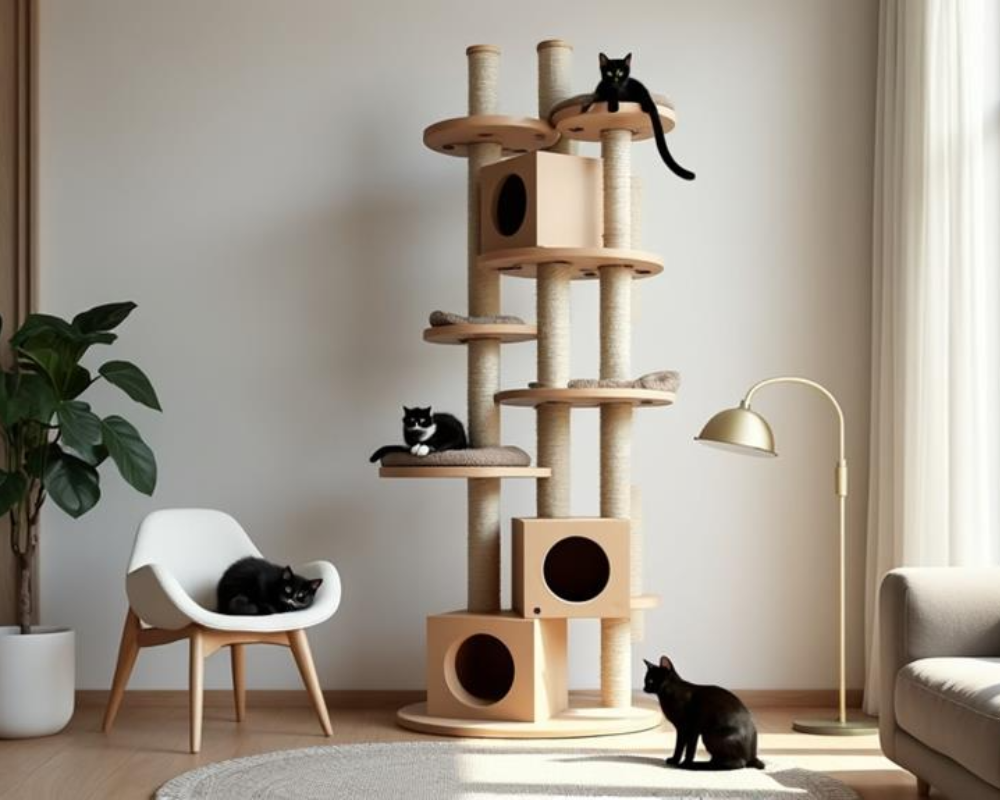
How to Choose a Cat Tree for Small Apartments
Share
How to Choose a Cat Tree for Small Apartments
Introduction: Making the Most of Small Spaces with Happy Cats
Living in a small apartment doesn’t mean you have to sacrifice your cat’s comfort, happiness, or natural instincts. Cats love to climb, scratch, and perch in high places. For many indoor cats, a cat tree becomes the ultimate playground, providing exercise, stimulation, and a cozy resting spot. But if you’re short on space, choosing the right cat tree can feel like a challenge. Luckily, with the right tips, you can find the perfect cat tree for small apartments that keeps your feline friend entertained without taking over your living room.
In this guide, we’ll walk through everything you need to know about choosing a cat tree for small apartments—from sizing and materials to placement, durability, and even style. By the end, you’ll know exactly what to look for and how to pick the best option for your furry roommate.
Why Cat Trees Are Essential for Apartment Cats
Cats Need Vertical Territory
Cats are natural climbers, and in the wild, they often find safety and comfort high above the ground. In small apartments where floor space is limited, vertical territory gives your cat room to explore without cluttering your home. A cat tree for small apartments maximizes height rather than width, letting your kitty climb, perch, and nap while saving valuable floor space.
Prevents Boredom and Destructive Behavior
Without stimulation, indoor cats may scratch furniture, climb curtains, or knock things off shelves. A cat tree provides an outlet for scratching and climbing, keeping them mentally and physically engaged. By giving your cat their own “apartment within your apartment,” you protect your furniture while making your pet happier.
Promotes Exercise in Small Spaces
Small apartments often limit opportunities for cats to run around. A multi-level cat tree encourages jumping and stretching, keeping muscles strong and preventing weight gain. It’s especially beneficial for younger, energetic cats who need daily play.
Key Factors When Choosing a Cat Tree for Small Apartments
1. Size and Dimensions Matter
When shopping for a cat tree for small apartments, measure your space carefully. Consider ceiling height, corner availability, and how much floor area you can spare. Compact designs, tall and narrow models, or wall-mounted cat trees are ideal for tight spaces. Always check the base size to ensure stability without overwhelming your room.
2. Height vs. Floor Space
If you’re short on floor space, choose a tall, slim design that gives your cat height to climb. Ceiling-high cat trees or wall-mounted perches maximize vertical territory. If your apartment has low ceilings or narrow walls, go for medium-height designs with multiple platforms.
3. Stability and Safety
No matter how small your space is, stability should never be compromised. Cats jump, scratch, and climb with energy, so a wobbly tree can be unsafe. Look for a sturdy base, strong materials, and secure attachments. Wall-mounted cat trees can also be a smart choice in small apartments, since they anchor directly to the wall for added stability.
4. Scratching Surfaces and Materials
Cats scratch to mark territory, stretch muscles, and keep claws healthy. Choose a cat tree that includes scratching posts wrapped in sisal rope or durable fabric. Avoid flimsy materials that wear down quickly. If your cat prefers a particular texture (rope, carpet, or wood), select a tree that matches their preference.
5. Comfort Features
Even in small apartments, cats love cozy hideaways. Many cat trees include hammocks, cubbies, or padded perches. These provide your cat with resting spots while giving them their own space away from the hustle of the household. A well-designed cat tree doubles as a sleeping nook and play area.
6. Style and Design for Apartments
Your apartment is your home, and style matters. Luckily, modern cat trees come in sleek designs, neutral colors, and furniture-like aesthetics that blend with your décor. Minimalist wooden cat trees or Scandinavian-style designs can enhance your apartment instead of clashing with it.
Best Types of Cat Trees for Small Apartments
Wall-Mounted Cat Trees
Wall-mounted options save valuable floor space and create vertical climbing structures. These often include shelves, hammocks, and wall steps that let your cat explore without taking up room. Perfect for modern apartments, they’re customizable and can be expanded over time.
Compact Multi-Level Towers
Tall, narrow towers with multiple platforms allow cats to climb without hogging floor space. These are ideal for corners or beside windows, giving your cat a great view of the outside world.
Window Perch Cat Trees
If your cat loves bird-watching, a cat tree designed with window perches is perfect. These maximize your cat’s entertainment by combining vertical climbing with a front-row seat to the outside world.
Convertible Cat Trees
Some modern cat furniture doubles as bookshelves, side tables, or storage. If you’re limited on space, a convertible cat tree gives you functionality for both you and your cat.
Placement Tips for Cat Trees in Small Apartments
Use Corners Efficiently
Corners are underused in many apartments. Placing a tall, narrow cat tree in a corner keeps it out of the way while giving your cat a private playground.
Near Windows for Enrichment
Cats love natural light and outdoor views. Placing your cat tree near a window turns it into a lookout tower, keeping your cat entertained while saving space.
Bedroom or Living Room Spots
Think about where your cat spends the most time. Placing the cat tree where you relax, like the living room or bedroom, helps them feel included while having their own designated spot.
Maintaining and Cleaning a Cat Tree in an Apartment
Regular Cleaning
Apartments can feel crowded if pet hair accumulates. Vacuum or lint-roll your cat tree weekly to keep fur under control. Removable cushions or washable pads make cleaning easier.
Replacing Scratching Posts
Sisal rope or fabric posts may wear down over time. Many modern cat trees offer replaceable scratching posts, so you can refresh the tree without replacing the entire structure.
Safety Checks
Check for loose screws, wobbling platforms, or worn-out parts regularly. A safe cat tree not only protects your cat but also ensures your apartment stays neat and organized.
Choosing the Right Cat Tree for Your Cat’s Personality
For Active Climbers
If your cat is adventurous, choose a tall tree with multiple climbing levels. Active cats will thrive with more vertical options.
For Shy Cats
Shy cats may prefer enclosed cubbies or hammocks for security. Look for compact trees with hiding spaces where they can feel safe.
For Multiple Cats
If you have more than one cat, opt for a taller tree with several perches. This prevents fights over territory while giving each cat a space of their own.
FAQs About Cat Trees for Small Apartments
Do cats really need a cat tree in small apartments?
Yes. Cat trees give cats vertical space to climb, scratch, and relax—essential for mental and physical health in confined areas.
How tall should a cat tree be for small apartments?
Look for medium to tall cat trees, around 3–6 feet. The key is choosing slim designs that maximize vertical height without taking up too much floor space.
Are wall-mounted cat trees better for small apartments?
Wall-mounted trees are great for saving space, especially in tight apartments. They’re stable, stylish, and customizable.
Can a cat tree replace scratching posts?
Yes and no. Most cat trees include scratching posts, but if your cat is a heavy scratcher, an additional scratching post may be helpful.
Conclusion: The Perfect Cat Tree for Your Apartment
Choosing the best cat tree for small apartments is about balancing your cat’s needs with your limited space. By prioritizing vertical designs, stability, comfort, and style, you’ll create a happy environment for your feline without overwhelming your home. A well-placed cat tree not only prevents boredom and destructive behavior but also becomes a stylish addition to your apartment.
Investing in the right cat tree is one of the best decisions you can make as a cat parent in a small space. Your cat will thank you with more play, more naps, and more love.
